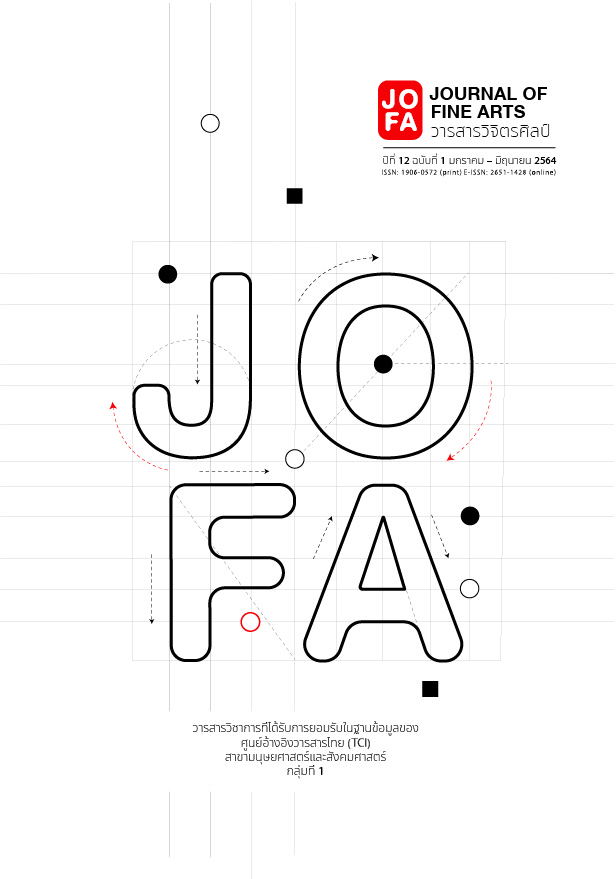Factors affecting the similarity-difference of houses In the forest concession period in Lampang and Phrae
Main Article Content
Abstract
This article aims to study the architectural formats of Thai residential houses built during the forest concession period (1855 - 1960), and the factors of their similarity and difference. The research is based on field studies, using the communities within Wiang Nuea subdistrict, Mueang district, Lampang, and Nai Wiang subdistrict, Mueang district, Phrae as the study area. The houses are selected with purposed sampling method, using specific characters as the criteria, which results in 21 houses Lampang, and 21 houses in Phrae.
The result shows that Thai residential houses could be divided into 2 groups namely: traditional architecture, which is the house with an inherited functional planning format from the past, and modern/applied architecture, which is the house with exterior features that are related to or reflect Western influence and has greater variety of planning formats than the traditional architecture group. The group can be categorized into 3 subgroups namely: 1) House owned by foreigners, has apparent Western influence, 2) House owned by local royals/ government officials, has Western influence with an applied planning format and 3) House with Western influence but still remains traditional planning format.
The factors leading to houses’ similarity are geological characteristics, local culture, local beliefs and attitudes to wood utilization, relationship between house orientation and city axis, Siamese government reformation, and usage of modern construction material and techniques. In contrast, the factors that lead to the houses’ difference are Siamese government’s forest concession operation after reformation, and entry of both foreigners and people outside the communities.
Article Details
References
Chaturawong, C. “Mai Sak Læ Sathāpattayakam Khō̜ng Phamā: Phāp Sathō̜n Kānmư̄ang Nai Samai Phračhao Min Dong Læ Phračhaothī Bō̜. [Burma’s Teak and Architecture of Buddhist Monasteries: Reflections on the Politics of King Mindon and King Thibaw].” Journal | NAJUA: History of Architecture and Thai Architecture 1, (January 2004): 14 – 41.
Chungsiriarak, S. Sathāpattayakam Bǣp Tawantok Nai Sayām Samai Ratchakān Thī 4 - Phō̜.Sō̜. 2480. [Western architecture in Siam during the reign of Rama IV -1937]. Bangkok: Faculty of Architecture, Silpakorn University, 2010.
Khrouthongkhieo, N. Pœ̄t Phǣn Yưt Lānnā. [The plan to rule Lanna].Bangkok: Matichon, 2017.
Khrouthongkhieo, N. and Chularatana, J. “Rat Sayām Kap Lānnā Phō̜.Sō̜. 2417 – 2476. [The Siamese State and Lanna, 1874 - 1933].”Journal of Humanities and Social Sciences 6, 11 (January/June 2014): 63 - 77.
Klomlaew, T. “Nǣothāng KānʻAnurak Rư̄an Mai Phư̄n Thin Nai Khēt Thētbānmư̄ang Phrǣ. [A Conservation Guideline for Vernacular Wooden House in Phrae Municipality Area].” Master’s thesis, Department of Architecture, Chiang Mai University, 2009.
Kosintranont, N. “Rūpbǣp Khō̜ng Rư̄an Phak ʻĀsaithī Dai Rap ʻItthiphon Tawantok Thī Samphan Kap Kān Sampathān Pāmai. [Patterns of Houses with Western Influence, Related to Forest Concessions in Lampang and Phrae].” Research Proceeding in The 10th Graduate integrity Conference, King Mongkut’s Institute of Technology Ladkrabang, April 26, 2019.
Ongsakul, S. Lum Mǣnam Wang: Prawattisāt Watthanatham. [Wang Basin: Cultural History]. Chiang Mai: Faculty of Humanities, Chiang Mai University, 2015.
_________. Prawattisāt Lānnā. [History of Lanna]. Bangkok: Amarin, 2014.
Poonthachak, P. “Kān Plīanplǣng.Thāng.Sētthakit Nai Monthon Phāyap Lang Kān Tatsēn Thāng Rotfai Sāi Nư̄a Phō̜.Sō̜. 2464 - 2484. [Economic Changes in Monthon Pha-Yap after The Construction of the Northern Railway, 1921 - 1941].” Master’s thesis, Department of History, Silpakorn University, 1987.
Sunthornswat, C. “Kānsưksā Chœ̄ng Prawattisāt Kīeokap Kitčhakān Pāmai Phāk Nư̄a Khō̜ng Thai Tangtǣ Phō̜.Sō̜. 2439 Thưng Phō̜.Sō̜. 2475. [A Historical Study of Forestry in Northern Thailand from 1896 to 1932].” Master’s thesis, Department of History, Chulalongkorn University, 1978.
Temiyabandha, V. Khati Khwām Chư̄a Bāng Prakān Nai Ngān Sathāpattayakam Thai. [Beliefs in Thai Architecture]. Bangkok: Triple Group, 2014.


